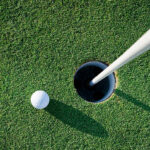If you’ve ever wondered how big is a golf ball, or whether those balls from the driving range are the same size as regulation ones used on the course, then this blog post is for you. From understanding how to measure golf ball size to exploring what kind of impact different sizes can have on performance, we’ll dive into this oft-neglected aspect of golfing and provide an answer as to what exactly makes a “golf-ball sized” sphere.
Contents
Understanding Golf Ball Diameter

As per the USGA Rules of Golf, the minimum diameter of a golf ball should be 1.680 inches (42.67 mm). Generally, a smaller golf ball will travel farther compared to a larger one with equal weight. The reason behind this is that a smaller diameter ball experiences less air resistance.
Technology And Golf Ball Design
With the advances in technology, manufacturers have been able to create golf balls with varying sizes and dimple patterns to optimize performance. These variations can affect the ball’s trajectory, spin rate, and distance traveled.
Spherical Symmetry Of The Golf Ball
One important aspect of a golf ball’s design and construction is its spherical symmetry. This means that the ball should be perfectly round with no flat spots or bulges. Any deviation from this shape can greatly affect the aerodynamics and performance of the ball.
Golf Ball Initial Velocity
The initial velocity of a golf ball is the speed at which it leaves the clubface upon impact. According to the USGA Rules of Golf, this velocity must not exceed 250 feet per second (76.2 meters per second). This limit ensures fair competition and prevents players from gaining an unfair advantage.
The History Of Golf Ball Sizes
Golf balls have come a long way since they were first used in the 14th century. Initially, golf balls were made of wood and had varying sizes. However, in 1932, the USGA standardized golf ball size to be at least 1.62 inches (41.15 mm) in diameter. In 1976, the USGA further increased the minimum diameter to 1.680 inches (42.67 mm) to improve consistency and fairness in the game. This is the standard size that is still used today.
How Big Is A Golf Ball?
Golf Ball Weight
See more : How Much Does A Golf Cart Weigh? [New update in 2023]
In addition to diameter, the USGA also regulates the weight of golf balls. According to their rules, a golf ball cannot weigh more than 1.620 ounces (45.93 grams). This ensures that all players are using balls with similar weight and size for fair competition.
Golf Ball Size
When it comes to the actual size of a golf ball, there may be slight variations due to manufacturing processes. However, as per the USGA rules, the diameter must be within 0.005 inches (0.127 mm) of the standard 1.680-inch measurement.
Types Of Golf Balls And Their Diameters
Manufacturers have developed different types of golf balls that cater to various playing styles and skill levels. These include two-piece, three-piece, and multi-layered golf balls with varying sizes and dimple patterns. However, all these balls must adhere to the USGA’s regulations on size and weight.
How Diameter Affects Golf Ball Performance?
A golf ball’s diameter can greatly impact its performance. As mentioned earlier, a smaller diameter ball tends to travel farther due to less air resistance. Additionally, the dimple pattern also plays a crucial role in determining how far a ball travels and how it behaves on the course.
Choosing The Right Golf Ball Diameter For Your Game
When it comes to choosing the right golf ball size, there is no one-size-fits-all solution. It ultimately depends on your playing style and preferences. However, it’s essential to keep in mind the USGA regulations and choose a ball that fits within those parameters for fair competition.
For Recreational Players
See more : How Much Is My Golf Cart Worth? Get An Accurate Answer
Recreational players can opt for golf balls with a smaller diameter for increased distance and forgiveness. These balls are typically softer and have larger dimples to help minimize slices and hooks.
For Professional Players
Professional players, on the other hand, may prefer golf balls with a slightly bigger diameter for better control and spin rates. These balls tend to be firmer and have shallower dimples for more precise shots.
Golf Ball Diameter Myths And Misconceptions

There are many myths and misconceptions surrounding the size of golf balls. Some players believe that using a smaller diameter ball can give them an advantage on the course. However, as we’ve discussed, the USGA regulations ensure that all players use balls with similar sizes and weights, thus eliminating any advantage. Another common misconception is that larger golf balls are easier to hit. While a larger ball may seem like an easier target, the difference in size is minimal and should not make a significant impact on a player’s performance.
FAQ: Golf Ball
Is a golf ball 4 cm?
The diameter of a standard size golf ball is not 4 cm, but rather 4.27 cm.
What is the radius of a golf ball?
The radius of a golf ball is approximately 0.85 inches.
How many golf balls can fit in a Boeing 747?
The freighter variant of the Boeing 747-8 has a cargo capacity of approximately 858,100 litres and a fuel capacity of 226,095 litres, resulting in a total volume of roughly 1,084,195 litres. Given that a golf ball has a diameter of 42.67 mm and a volume of 0.041 litres, the available space can accommodate around 26,652,678 golf balls.

Jamie Sadlowski is one of the most remarkable golfers in the world. He’s a two-time World Long Drive Champion, and he’s currently ranked 4th in the world. His story is one of perseverance, hard work, and passion for the game. Let’s take a closer look at this inspiring athlete.
The Early Years
Jamie Sadlowski was born in St. Paul, Alberta, Canada. He started playing golf at a young age and quickly developed an affinity for the sport. As he grew older, his passion for golf only deepened and he eventually decided to pursue it as a career. After graduating from high school in 2006, Jamie enrolled at the University of Nebraska-Lincoln where he studied business and played collegiate golf for three years. In 2009, he decided to leave college early to pursue his dream of becoming a professional golfer .








How long should I use a golf ball?
Do golf balls really make a difference?
How many rounds is a golf ball designed to last?
I have played the same orange Titlelist velocity off and on for about 2 seasons now. So probably 20 rounds or so. It is still fine.
Yes. Pick the brightest colored ball you can find and play those. It will make it much easier to find.
I buy cheap balls (Noodles) so I don’t spend much time looking for them. They last about 6 holes if I don’t lose it first. If I get in the bunkers, it may last two bunker shots.